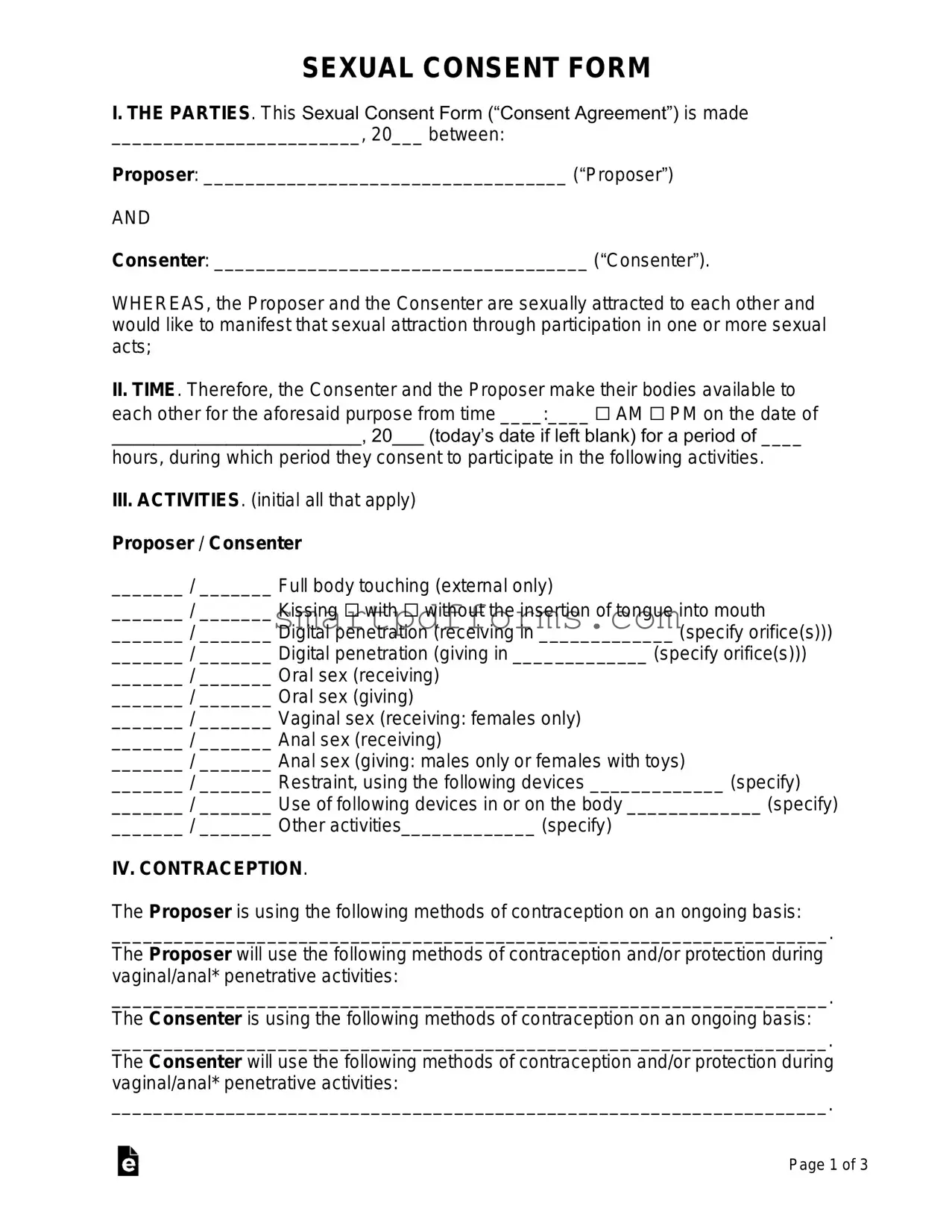SEXUAL CONSENT FORM
I. THE PARTIES. This Sexual Consent Form (“Consent Agreement”) is made
________________________, 20___ between:
Proposer: ___________________________________ (“Proposer”)
AND
Consenter: ____________________________________ (“Consenter”).
WHEREAS, the Proposer and the Consenter are sexually attracted to each other and would like to manifest that sexual attraction through participation in one or more sexual acts;
II.TIME. Therefore, the Consenter and the Proposer make their bodies available to each other for the aforesaid purpose from time ____:____ ☐ AM ☐ PM on the date of
________________________, 20___ (today’s date if left blank) for a period of ____
hours, during which period they consent to participate in the following activities.
III.ACTIVITIES. (initial all that apply)
Proposer / Consenter
_______ / _______ Full body touching (external only)
_______ / _______ Kissing ☐ with ☐ without the insertion of tongue into mouth
_______ / _______ Digital penetration (receiving in _____________ (specify orifice(s)))
_______ / _______ Digital penetration (giving in _____________ (specify orifice(s)))
_______ / _______ Oral sex (receiving)
_______ / _______ Oral sex (giving)
_______ / _______ Vaginal sex (receiving: females only)
_______ / _______ Anal sex (receiving)
_______ / _______ Anal sex (giving: males only or females with toys)
_______ / _______ Restraint, using the following devices _____________ (specify)
_______ / _______ Use of following devices in or on the body _____________ (specify)
_______ / _______ Other activities_____________ (specify)
IV. CONTRACEPTION.
The Proposer is using the following methods of contraception on an ongoing basis:
_____________________________________________________________________.
The Proposer will use the following methods of contraception and/or protection during vaginal/anal* penetrative activities:
_____________________________________________________________________.
The Consenter is using the following methods of contraception on an ongoing basis:
_____________________________________________________________________.
The Consenter will use the following methods of contraception and/or protection during vaginal/anal* penetrative activities:
_____________________________________________________________________.
V. RATCHET CLAUSE. Whereas the Proposer and the Consenter are aware that attraction may escalate during the agreed upon sexual activities, and that both parties may desire to engage in activities heretofore not consented to, the parties agree as follows. (check one)
☐- There shall be no sexual activity of any kind other than that specified and consented to in this Consent Agreement without the establishment of a new, separate agreement. (See Clause 1 below.)
Initialed (Proposer) _________ Initialed (Consenter) ________
☐- Sexual activity of a kind other than that specified and consented to in this Consent Form shall be presumed to be consented to with the retroactive checking of the appropriate activity above, even after the signing of this Consent Form. (See clause 1 below.)
Initialed (Proposer) _________ Initialed (Consenter) ________
☐- Sexual activity of a kind other than that specified and consented to in this Consent Form shall be presumed to be consented to by mutual verbal consent during the activities engaged in under the consent given in the present Consent Form. (See Clause 2 below.)
Initialed (Proposer) _________ Initialed (Consenter) ________
Clause 1. Whereas both Proposer and Consenter recognize that alternatives a) and b) are likely significantly to disrupt any activities consented to under this Consent Agreement;
Therefore, the Proposer and the Consenter further agree that should the disruption of agreed activities, caused by the making of a further Consent Agreement (under a) above) or the retroactive amendment of this Consent Agreement (under b) above), result in a loss of desire to continue the activities herein consented to, consent for those activities consented to herein may/may not* be withdrawn by the verbal statement of one of the parties to this Consent Agreement.
Clause 2. Whereas both Proposer and Consenter recognize that alternative c) involves verbal consent of which no physical evidence will exist thereafter; Therefore, the Proposer and the Consenter further agree that such consent shall/shall not* be recorded using an audio recording device; and Whereas both Proposer and Consenter recognize that should no audio recording of verbal consent under this ratchet clause be made, neither party could subsequently prove affirmative consent to the activities that were verbally agreed upon; Therefore, both parties hereby waive their right to claim that no such affirmative consent was given. Equivalently, the Proposer and the Consenter hereby consent to any further activities that can be reasonably deemed to follow naturally from the activities herein consented to.
VI. ACCIDENTAL VIOLATION. Whereas sexual activity is likely to involve rapid movement and impaired judgment; Whereas either party to this Consent Agreement, being male, may, through no fault and without intent, penetrate a female orifice not made available for sexual activity under this Consent Agreement; Therefore, the Proposer and the Consenter agree as follows;
☐- Such an incident shall be regarded as an assault and the burden of proof to the contrary shall fall on the male party to demonstrate to the satisfaction of the female party that the incident was accidental, and acceptance of such a demonstration shall be taken as implying retroactive affirmative consent;
☐- Such an incident shall be regarded as an accident, and retroactive affirmative consent will be assumed.
VII. FAILURE TO PERFORM. Whereas consent to participate in sexual activities does not guarantee ability to perform those activities, Therefore, failure to perform such as acts as consented to under this Consent Agreement for reasons including, but not limited to physical, psychological or emotional impairment, shall not be considered a violation of this Consent Agreement; and both the Proposer and the Consenter waive any right to legal redress for such failure to perform.
VIII. EARLY TERMINATION. This Consent Agreement may be terminated at any time during the period of consent agreed upon herein by mutual written consent of both the Proposer and the Consenter.
Proposer’s Signature _____________________________ Date ________________
Consenter’s Signature _____________________________ Date ________________
(optional)
Witness’s Signature _____________________________ Date ________________



